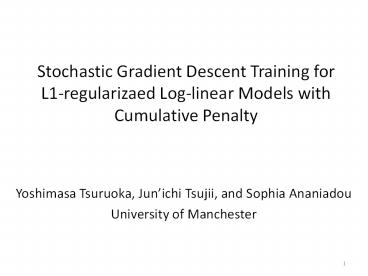Stochastic Gradient Descent Training for L1-regularizaed Log-linear Models with Cumulative Penalty - PowerPoint PPT Presentation
Title:
Stochastic Gradient Descent Training for L1-regularizaed Log-linear Models with Cumulative Penalty
Description:
Stochastic Gradient Descent Training for L1-regularizaed Log-linear Models with ... Stochastic gradient descent training for L1-regularized log-linear models ... – PowerPoint PPT presentation
Number of Views:294
Avg rating:3.0/5.0
Title: Stochastic Gradient Descent Training for L1-regularizaed Log-linear Models with Cumulative Penalty
1
Stochastic Gradient Descent Training for
L1-regularizaed Log-linear Models with Cumulative
Penalty
- Yoshimasa Tsuruoka, Junichi Tsujii, and Sophia
Ananiadou - University of Manchester
2
Log-linear models in NLP
- Maximum entropy models
- Text classification (Nigam et al., 1999)
- History-based approaches (Ratnaparkhi, 1998)
- Conditional random fields
- Part-of-speech tagging (Lafferty et al., 2001),
chunking (Sha and Pereira, 2003), etc. - Structured prediction
- Parsing (Clark and Curan, 2004), Semantic Role
Labeling (Toutanova et al, 2005), etc.
3
Log-linear models
- Log-linear (a.k.a. maximum entropy) model
- Training
- Maximize the conditional likelihood of the
training data
Feature function
Weight
Partition function
4
Regularization
- To avoid overfitting to the training data
- Penalize the weights of the features
- L1 regularization
- Most of the weights become zero
- Produces sparse (compact) models
- Saves memory and storage
5
Training log-linear models
- Numerical optimization methods
- Gradient descent (steepest descent or
hill-climbing) - Quasi-Newton methods (e.g. BFGS, OWL-QN)
- Stochastic Gradient Descent (SGD)
- etc.
- Training can take several hours (or even days),
depending on the complexity of the model, the
size of training data, etc.
6
Gradient Descent (Hill Climbing)
objective
7
Stochastic Gradient Descent (SGD)
objective
Compute an approximate gradient using
one training sample
8
Stochastic Gradient Descent (SGD)
- Weight update procedure
- very simple (similar to the Perceptron algorithm)
learning rate
9
Using subgradients
- Weight update procedure
10
Using subgradients
- Problems
- L1 penalty needs to be applied to all features
(including the ones that are not used in the
current sample). - Few weights become zero as a result of training.
11
Clipping-at-zero approach
w
- Carpenter (2008)
- Special case of the FOLOS algorithm (Duchi and
Singer, 2008) and the truncated gradient method
(Langford et al., 2009) - Enables lazy update
12
Clipping-at-zero approach
13
- Text chunking
- Named entity recognition
- Part-of-speech tagging
Number of non-zero features
Quasi-Newton 18,109
SGD (Naive) 455,651
SGD (Clipping-at-zero) 87,792
Number of non-zero features
Quasi-Newton 30,710
SGD (Naive) 1,032,962
SGD (Clipping-at-zero) 279,886
Number of non-zero features
Quasi-Newton 50,870
SGD (Naive) 2,142,130
SGD (Clipping-at-zero) 323,199
14
Why it does not produce sparse models
- In SGD, weights are not updated smoothly
15
Cumulative L1 penalty
- The absolute value of the total L1 penalty which
should have been applied to each weight - The total L1 penalty which has actually been
applied to each weight
16
Applying L1 with cumulative penalty
- Penalize each weight according to the difference
between and
17
Implementation
10 lines of code!
18
Experiments
- Model Conditional Random Fields (CRFs)
- Baseline OWL-QN (Andrew and Gao, 2007)
- Tasks
- Text chunking (shallow parsing)
- CoNLL 2000 shared task data
- Recognize base syntactic phrases (e.g. NP, VP,
PP) - Named entity recognition
- NLPBA 2004 shared task data
- Recognize names of genes, proteins, etc.
- Part-of-speech (POS) tagging
- WSJ corpus (sections 0-18 for training)
19
CoNLL 2000 chunking task objective
20
CoNLL 2000 chunking non-zero features
21
CoNLL 2000 chunking
- Performance of the produced model
Passes Obj. Features Time (sec) F-score
OWL-QN 160 -1.583 18,109 598 93.62
SGD (Naive) 30 -1.671 455,651 1,117 93.64
SGD (Clipping Lazy Update) 30 -1.671 87,792 144 93.65
SGD (Cumulative) 30 -1.653 28,189 149 93.68
SGD (Cumulative ED) 30 -1.622 23,584 148 93.66
- Training is 4 times faster than OWL-QN
- The model is 4 times smaller than the
clipping-at-zero approach - The objective is also slightly better
22
NLPBA 2004 named entity recognition
Passes Obj. Features Time (sec) F-score
OWL-QN 160 -2.448 30,710 2,253 71.76
SGD (Naive) 30 -2.537 1,032,962 4,528 71.20
SGD (Clipping Lazy Update) 30 -2.538 279,886 585 71.20
SGD (Cumulative) 30 -2.479 31,986 631 71.40
SGD (Cumulative ED) 30 -2.443 25,965 631 71.63
Part-of-speech tagging on WSJ
Passes Obj. Features Time (sec) Accuracy
OWL-QN 124 -1.941 50,870 5,623 97.16
SGD (Naive) 30 -2.013 2,142,130 18,471 97.18
SGD (Clipping Lazy Update) 30 -2.013 323,199 1,680 97.18
SGD (Cumulative) 30 -1.987 62,043 1,777 97.19
SGD (Cumulative ED) 30 -1.954 51,857 1,774 97.17
23
Discussions
- Convergence
- Demonstrated empirically
- Penalties applied are not i.i.d.
- Learning rate
- The need for tuning can be annoying
- Rule of thumb
- Exponential decay (passes 30, alpha 0.85)
24
Conclusions
- Stochastic gradient descent training for
L1-regularized log-linear models - Force each weight to receive the total L1 penalty
that would have been applied if the true
(noiseless) gradient were available - 3 to 4 times faster than OWL-QN
- Extremely easy to implement































